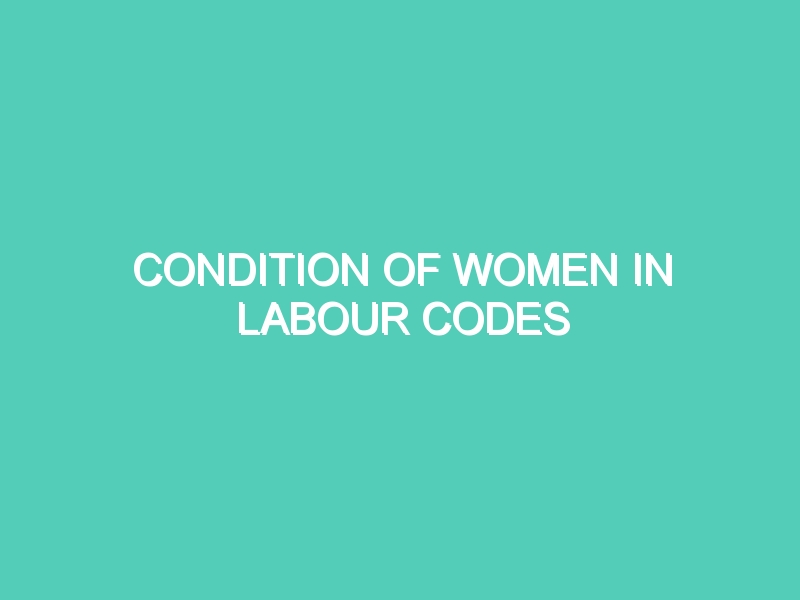The labour market in India is marked with various laws and programmes which have often at times proven as ineffective and has been suggested for a better and an efficient implementation. Such non-adherence has led to causing a detrimental impact to the society, especially women. In this current age and generation, these workers must be provided with more opportunities and allow for more participation of women.This article aims to put light on various issues observed in the various legislations and schemes which have failed to provide women with their entitlements and rights leading to an unproductive outcome. Moreover, the article also focuses on the part of the upcoming legislations which have been introduced in the Parliament for enactment and shreds some light in relation to the issue.
Since the adoption of the new economic policy in 1991, there has been a negative growth hovering around the labour migration, highlighting the employment crisis which has now become highly gendered with the fall in women workforce. While Indian men account for more than 80% migrant population, Census shows the increase on female migrants to 16%[1]. It also reveals the majority being the rural population in an increase of around 58% to urban destinations[2]. Since the publication in the reports, this figure has further increased. The women participation has dropped to 23.3% as per the Periodic Labour Force Survey in 2017[3]. Moreover, India has been ranked as 108th in the Global Gender Gap Report out of 149 countries participating in it[4].The unemployment rate also grew among women to almost around 11%[5]. Amidst all the data, the coercion experienced in relation to job security has vastly increased impacting workers at a large scale making it essential to restructure the policies and laws.
CONSTITUTIONAL & LEGISLATION FRAMEWORK
Article 16 of the Constitution provides for the protection of people from any kind of discrimination in employment under the Right to Equality Scheme[6]. Furthermore, Article 23 enshrines the possibility of any sort of exploitation to workers and prohibits forced labour[7]. The workers amidst the fundamental rights, are also guaranteed with Directive Principles of State Policies (DPSP’s) to provide for protection to workers. Though the existence of Article 15(3)[8] empowers the state to make laws in favour of women and children, Articles 39-42[9] within such framework tries to uphold protection of women workers. This includes the principle of equal pay for equal work emphasizing the need for laws to be more gender-neutral based.Besides these, various committees have also been set up to analyse and review the position of women workers in the economy and try to uplift their position to enable their protection of interests, such as the Committee on Status of Women in India (1974), National Perspective Plan for Women, National Commission for Women etc.
Many statutes have set mark for regulating the workplace conditions and issuing guidelines for providing the basic rights to the workers employed including health and safety measures, suchas the Factories Act, Minimum Wages Act, Employee State Insurance Act, Employee Provident Fund Act etc. However, majority of the legislations have denied the workers with their entitlements, especially when it comes to women. Many statutes work unoperated despite their existence like the Equal Renumeration Act which was brought in 1970’s but has highly been critiqued for its implementation and compliance towards its objective[10].Moreover, the right to collective bargaining which is listed as one of the most core convention by the International Labour Organization (ILO) hasn’t been ratified by India, though in its essence claims to provide for such rights. The categorization of the migrant and the non-migrants have led to further dilution of the above rights to be provided which in turn has resulted in the impairment of conditions of women. As per traditions, women have been considered to be referred to as a family unit and thus, the dispersion of wages denies her right to have any claim of her individual share of it. Though, the concept of family is a completely different topic, in essence, the denial of such rights remains the same.
The Inter-State Migrant Workmen Act, 1979 remains the sole Act till date which regulates the employment conditions for migrants[11]. Interestingly, it has neglected intra-state migrants from its ambit and scope which till date stands as valid with no attempts to reform it.It operates in tandem with the Bonded Labour System (Abolition) Act, 1976 against the labour bondage in migration.Both these statutes were enacted during the Emergency regime indicating an authoritarian chain. As per the National Commission for Enterprises in Unorganized Sectors, both the statutes have resulted as ineffective in achieving their object on the ground reality situations[12]. Moreover, as reported, even the involvement of judiciary to remove the disparities of gender neutrality existing because of these legislations isn’t enough as it is yet to implement procedural effects[13]. The judgement ofPeople Union for Democratic Rights v. Union of India, the definition of forced labour was expanded to include all workers and labourers who have been paid less than the required wage as specified in the statute[14]. The main focus of the government must be to remove the disabilities faced by women which act as obstructions during their work and provide more and new employment opportunities. Though, developments have been made towards women by imposing regulations and guidelines with respect to lifting weights to working in mines to maternity benefits to night duty for some jobs to creation of crèches etc., a majority of it applies to organized sectors denying the accessibility of rights to those who belong to the unorganized sector.These developments have been highlighted in various statutes including the Factories Act, Mines Act, Plantation Labour Act, Maternity Act, Payment of Gratuity Act, Equal Renumeration Act, Contract Labour (Regulation & Abolition) Act, Minimum Wages Act etc. applying majorly to organized sectors.
WELFARE SCHEMES AND PROGRAMMES TO FACILITATE SAFEGUARDS
There have been multiple schemes and programmes introduced to help the women and other workers to facilitate their safety and health requirements at their workplace. The Insurance Scheme provides for making provisions of group insurance for the workers belonging to the unorganized sector through Life Insurance Corporation. Further, the scheme of Krishi Shramik Samaj Yojana was launched in 2001 which provided for the social security means and benefits to the agricultural workers[15]. Apart from this, schemes such as the Asha Kiran Scheme, Financial Assistance to the Landless Women Agricultural Labourers, Insurance cum Retirement Benefit Special Scheme etc were also introduced which aimed at providing maximum welfare to these categories of workers.Reports from the commissions set up have also recommended on the emergence of more groups for labour welfare for women and employment generation which needs to be brought by the government. Since then, there have been enactments of National Rural Employment Programme, Rural Landless Employment Guarantee Programme, Development of Women and Children in Rural Areas etc. for upliftment and promote women’s position in these sectors with better facilities and safeguards.
The National Commission of Labour was also set up for strengthening the sector and enforcing provisions in relation to health and safety of the workplace. Its major aim and focus were towards developing a proper umbrella legislation for protection of workers. The committee in its recommendations have stated the need for addressing the impacts caused to such people employed in the unorganized sector and make way for social security schemes. For women, Special Cells were built to focus on the women working in the unorganized sectorsand bringing improvement in their workplace by formulation of policies, making sure effective implementation of various programmes and Acts etc.The committees set up for evaluating the conditions in essence found out that the rights guaranteed to women have no meaning unless women’s right to independence is acknowledged and the Government ensures effective implementation of its schemes and policies. The setting up of the Women’s Welfare and Development Bureau has led to a positive progress for measuring such development. Its main function is to collect the data and coordinate the programmes by various ministries and monitor it towards attaining welfare and to communicate with international bodies who work for similar goals to discuss the legal issues prevailing.
THE UPCOMING INTRODUCTIONS OF LEGISLATIONS
The denial of social justice and rights to women workforce have thus led to efforts being made to improve their condition.The developments and evaluation of the role of women have to be seen with the changes in the society to decide its path ahead. Currently, India is gradually shifting to eliminate the multiplicity of laws by enacting four major key codes. Firstly, the Code on Wages which has been passed in 2019[16] defines the worker in relation to its industry, excluding home workers from its scope. It excludes the female domestic workers who after much resistance and struggle got themselves included within the Minimum Wages Act. It further excludes apprentices for any entitlement to minimum wages, thereby severely impacting the women workers who are at a disadvantage and nullifies their entitlements to some extent[17].Secondly, the Occupational Safety, Health and Working Conditions Code aims to repeal 13 labour laws varying over different types of industries[18]. It lays down the timings for women to be from 6 a.m. to 7 p.m. and also provides for the transportation facilities on account of the employer[19]. The Code again like the above excludes the home workers and thus the welfare provisions does not apply to them, giving an open interpretation. Further, it has repealed provisions of establishing creches, independent wages to women, protection from sexual harassment etc[20]. Though the Code in its aim tries to address the welfare schemes for workers, ironically it has ignored many key provisions of them, thus requiring attention and modification in the Bill. Thirdly, the Code on Social Security[21] lists out the benefits for various social security organizations and have led the government to decide on the various social schemes from time to time. Unlike others, this Code includes the home-based workers and domestic workers in the unorganized sector. It considers the Maternity Benefits and the provision of creches which is limited only to the organized sectors[22].Though this Code specifically addresses the flaws in the safety Code above, the aim remains to ensure the social security of the workers, rather than their health and improving their work conditions. The unorganized sector is taken care by respective state boards carried in form of public health programmes and schemes introduced by the states and also by the centre. Lastly, the Industrial Relations Code which through the involvement of women workers in groups and trade unions tries to address their rights[23].The Code retains the provisions with providing protection against illegally terminating the contracts or interfering with the business or any other rights to disposal of labour. However, it very inherently denies any forms of legal strikes organized by the trade unions and thereby denying any right to protest[24].
Thus, in overall, these new introductions overlook the gender aspect in the labour laws by making it more male-oriented and detrimental for the women in general. Though it addresses some issues to an extent, it also neglects various other aspects which needs to be addressed and modifications should be provided for before the Parliament passes them.
CONCLUSION
Such rigorous policies and guidelines have made employers expensive to maintain the labour of women making them hesitant towards employing them. With acts such as the Equal Renumeration Act to Maternity Benefits Act to providing creche facilities, the cost of upkeeping has made them resist towards womenemployment, ultimately being disadvantageous to them. The provisions of Factories Act have also had a negative effect making employers deter from employing women.The enforcement and implementation of the statutory requirement is ensured by the Office of Labour Commissioner. It becomes difficult on their part to ensure the strict adherence towards the welfare and the social security schemes being provided to the workers. Moreover, the workers if feel that their rights are violated and any sort of non-compliance is being done, they never take it forward to higher authorities in fear of losing out their jobs. Furthermore, many employers especially in the unorganized sectors have found out loopholes to evade the penal provisions to the violations and thus exploit the workers. Women at large are very prone to such unscrupulous activities undertaken by the employers where they are often treated with differential waging system and other provisions of the act mentioned above are not strictly adhered to.Additionally, the informal sector does not take into account the home-based workers and does not provide for any social security benefit, medical benefit and terms of employment, making it an area of complete exploitation. Thus, it becomes quite difficult for the agencies to regulate and identify the adherence of the laws and any unscrupulous activities being detrimental on the part of the workers, concerning their welfare, security, and work conditions.Their rights to form various unions have also been now suppressed by the upcoming introductions of labour codes, thereby making it more essential to provide with the necessary attention and providing them with safeguards. The role of non-governmental organizations in the light of thisattracts one’s attention to paly an active role. Since these organizations operate at a grass root level and are well versed with the practicalities of the situation and issues prevailing, thereby making them more effective and productive in their field of work. These organizations have to co-ordinate with the government to help addressand resolve the issue to an extent for making better lives of the workers, women especially. Though, there have been issues in the co-ordination in the past as reported, it regards as the only logical and conclusive solution which can actually make a progressive impact on the society to such women labourers, both in organized and unorganized sectors.
Article Written By-Kushal Tekriwal
(HRDI Work From Home Internship)
[1]Indrani Mazumdar & Neetha N, “Crossroads and Boundaries: Labour Migration, Trafficking and Gender” 55 Economic and Political Weekly (May, 2020).
[2]Ibid.
[3]Ministry of Statistics and Programme Implementation, “Periodic Labour Force Survey (PLFS)” (Government of India, 2019).
[4]Lavanya Arvind, “Do The New Labour Reforms Help Women?”Bloomberg Quint, January 3, 2020.
[5]Supra note 4.
[6]The Constitution of India, art. 16.
[7]Ibid at art. 23.
[8]Supra note 7 at art. 15(3).
[9]Supra note 7 at arts. 39-42.
[10]Supra note 2.
[11]The Inter-State Migrant Workmen (Regulation of Employment and Conditions of Service) Act, 1979 (Act No. 30 of 1979).
[12]National Commission for Enterprises in the Unorganised Sector, “Report on Conditions of Work and Promotion of Livelihoods in the Unorganised Sector” (Government of India, 2007).
[13]Supra note 2.
[14]People Union for Democratic Rights v. Union of India(1982) 3 SCC 235.
[15]Krishi Shramik Samaj Yojana, Ministry of Labour (2001), Accessed from <https://pibarchive.nic.in/archive/releases98/lyr2001/rjun2001/30062001/r300620012.html>.
[16]The Code on Wages, 2019 (Act No. 29 of 2019).
[17]Ibid.
[18]The Occupational Safety, Health and Working Conditions Code, 2019 (Bill No. 186 of 2019).
[19]Ibid.
[20]Supra note 19.
[21]The Code on Social Security, 2019 (Bill No. 375 of 2019).
[22]Ibid.
[23]The Industrial Relations Code, 2019 (Bill No. 364 of 2019).
[24]Ibid.



